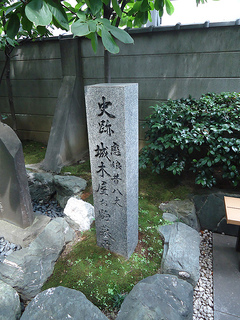Koi musume mukashi hachijo
- Playwrights: Matsu Kanshi, Yoshida Kadomaru
- Premiere: 1775/8, Geki-za (Edo)
- Other Names: お駒才三 (okoma saiza)
- Japanese: 恋娘昔八丈 (koi musume mukashi hachijou)
Koi musume mukashi hachijô is a fifth-category ningyô jôruri play and kabuki play.
Co-written by Matsu Kanshi and Yoshida Kadomaru, it premiered in the middle of the 8th month, 1775, at the Geki-za in Edo. The script was first published on 9/25 that year, and a kabuki version was first performed the following year, in 1776/3, at the Nakamura-za. Today, only the last two scenes, taking place at the Shirokiya lumber shop, and at the Suzugamori execution grounds, are typically performed.
Plot
The plot was based on a real event from 1726, in which timber merchant Shirokoya Matashirô, of Edo's Shin-zaimokuchô district, was killed. In the play, Chigusa-no-suke, the young lord of the Hagiwara family, who has become infatuated with a courtesan named Jûrokuya. He tries to pawn a family treasure, a precious tea container (chaire), in order to raise money to buy out the courtesan's contract; however, as a result of the schemes of the evil karô Shûgetsu Ikkaku, the container is stolen from him.
Meanwhile, one of the family's retainers, Obana Saizaburô, who has been enjoying a relationship with the maid Okoma, is stripped of his swords and expelled from the household, as punishment for engaging in such trysts; before he leaves, however, he swears to find and reacquire the precious tea container.
Saizaburô becomes a hairdresser, while Okoma returns to her parents' home, a timber shop known as the Shirokiya. She is betrothed to a man named Kizô, who, it turns out, was involved in the plot to steal the tea container. Jôhachi, an employee at the timber shop, finds out about his involvement in the scheme, and regains the tea container. He then suggests to Okoma that if she does not want to marry Kizô, he will gladly marry her, and then also suggests she poison and kill Kizô in his sleep.
In the final scene, Okoma has been arrested for the murder of Kizô, and sentenced to execution. Saizaburô appears, however, at the execution grounds, having captured Jôhachi. He reveals Jôhachi's involvement in the plot, and petitions for Okoma's release. She is then pardoned, to the cheers of the assembled crowd.
References
- "Koi musume mukashi hachijô," Sekai daihyakka jiten 世界大百科事典, Hitachi Solutions, 2012.
- "Okoma Saiza," Kabuki21.com.
